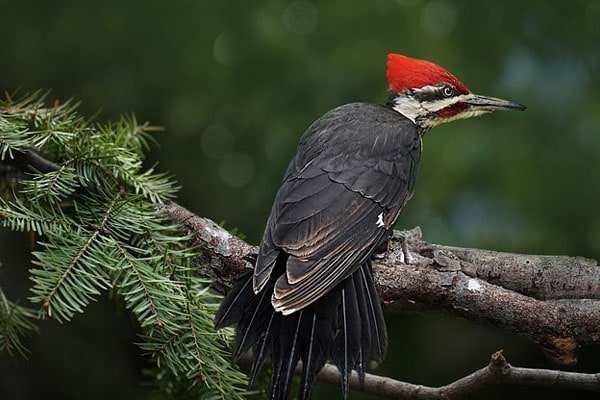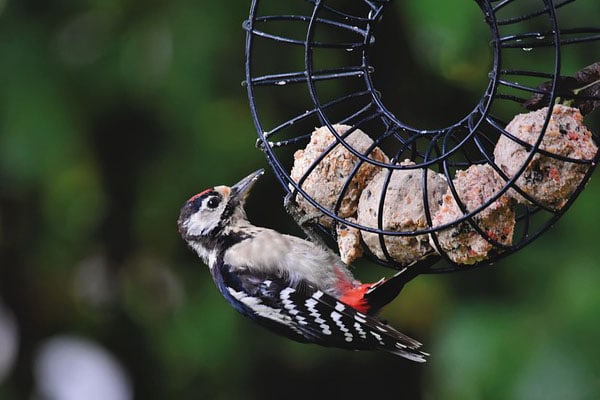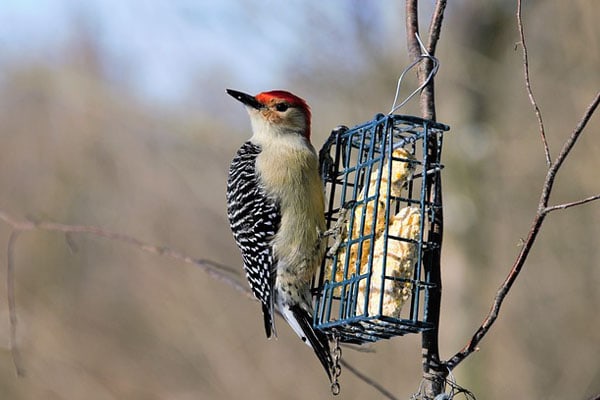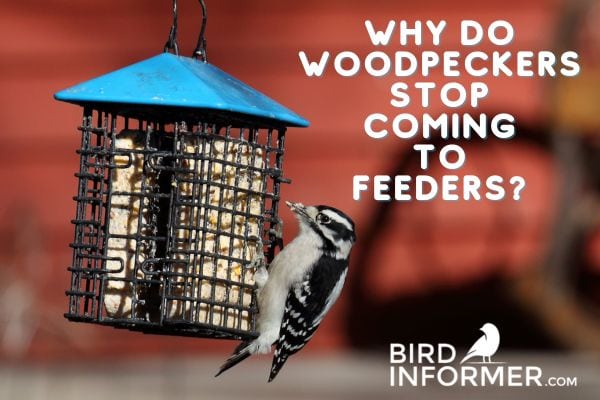Contents
Have you ever noticed that woodpeckers suddenly stopped coming to your suet feeders? One minute, your favorite feathered friends are visiting your bird feeders regularly. Then in the next minute, they suddenly disappear. Poof! They quickly vanish without a trace.
This situation is daunting, and many of us even find it puzzling. Why did they stop visiting the suet feeder? What changed to make them no longer want your tasty offerings?
As a bird enthusiast, you definitely want some answers. And you want them now!
On the one hand, it’s possible that another one of your neighbors is also putting up suet feeders in their backyard. They found this delicious food or another food source, and suddenly they no longer need your suet to meet their nutritional needs.
Did you know that woodpeckers are considered opportunistic birds? It’s the truth. If they find an abundant food source that’s readily available, they’ll tend to stick with that food source until it’s no longer viable.
So, it’s possible that they found another more appealing option. They may be foraging in another area brimming with delicious food to meet their nutritional needs.
Competition among other birds and animals for food at your suet feeder might also turn them away. Woodpeckers do not like extra competition. They want easy, hassle-free food without having to compete with other birds or animals that could get in their way and gobble up all of the delicious suet.
Additionally, seasonal changes can affect the presence of woodpeckers at your suet feeder. During warmer seasons, their diet may shift from fatty suet to insects they find within tree bark or in the garden.
You really need to recognize these factors and adapt your feeding practices accordingly. It’s the best way to continue supporting your local bird population, and especially the woodpeckers.
Why Woodpeckers Visit Suet Feeders

Before we dive headfirst into the reasons why woodpeckers stop coming to suet feeders, it’s important to understand why they visit them in the first place.
After extensively researching this topic, we’ve discovered a number of potential reasons why woodpeckers decided to visit your feeders in the first place. They include:
Nutritional Excellence: Offering Fresh and Tasty Suet to Meet Their Nutritional Needs
Woodpeckers visit suet feeders because these feeders provide them with essential nutrition. It shouldn’t surprise anyone to learn that the delicious morsels and suet are loaded with lots of calories, fats, and energy-filled goodness. This food is perfect for woodpeckers because it meets their dietary requirements and it’s quite beneficial to their overall health and well-being.
Let’s take the fat content, for example. In suet, the abundance of fats is perfect for these birds because it gives them the extra energy needed to fuel their daily activities. Maintaining territories, searching for food, and hammering away at tree trunks all day requires plenty of energy and lots of calories and fats to fuel their bodies.
Guess what? Suet often contains insect protein, which meets the protein requirements in their diet. Some key nutrients that woodpeckers require from suet include:
- Fats
- Proteins
- Vitamins
- Minerals
Changing Seasons: Seasonal Factors That Affect Suet Feeder Activity for Woodpeckers

The time of year also influences woodpeckers’ visits to suet feeders. In colder months, when insects and other food sources might become scarce, suet offers a reliable source of sustenance, ensuring they meet their energy requirements for survival. During the winter, providing this essential nutrition becomes even more critical as a means for you to support these fascinating birds in your backyard.
In the spring and summer, woodpeckers may still visit suet feeders since it supplements their normal diet of insects and supports their additional energy needs. However, during these seasons, they may not visit as often due to the abundance of other food sources.
Remember, attracting woodpeckers to suet feeders involves understanding their nutritional needs and considering seasonal factors that might influence their feeding habits.
Reasons for Woodpeckers Stopping Their Visits
Woodpeckers stop visiting suet feeders for a wide variety of reasons. It’s never as straightforward as it may seem. You may have changed the feeder location, or there may be too many other birds and animals vying for the suet. Or it could simply be a matter of switching brands, and the woodpeckers don’t like the new food for whatever reason.
Here’s a quick breakdown of the reasons woodpeckers may have stopped visiting your backyard bird feeders. They include:
Location, Location, Location: Changes in Feeder Location
Have you recently moved your feeder’s location?
Sometimes, a simple change in your suet feeder location can deter woodpeckers from visiting. Woodpeckers are naturally inclined to choose trees and other stable structures for their feeding spots. If you move your suet feeder to a less familiar or less stable location, woodpeckers may feel less secure and avoid it.
To encourage woodpeckers to return:
- Make sure the feeder is securely attached to a sturdy tree or post.
- Place the feeder near their natural habitat, preferably near trees with bark for them to peck on.
- Provide some cover from shrubs or nearby branches to protect them from predators.
Fierce Competition: Your Suet Might Be in Short Supply
Woodpeckers may stop visiting your suet feeder if there’s too much competition for the food source. If other birds or even squirrels are dominating the feeder, woodpeckers might have difficulty accessing the suet.
To alleviate this issue:
- Consider getting a feeder specifically designed for woodpeckers, with a tail prop to make it easier for them to feed.
- Offer multiple suet feeders or separate feeders for other birds to reduce competition.
- Omit any birdseed that might attract other birds and instead focus on suet blocks.
Making the Right Choice: Suet Quality and Preferences

Suet is available in abundant supply. Sometimes, the quality isn’t what it’s cracked up to be. And other times, woodpeckers may not like a particular taste or flavor. This all depends on the different suet options that you’re providing in your bird feeders
Even more shocking: Woodpeckers are picky eaters! I find this hard to believe because they’ve also been labeled opportunistic feeders, which means they’d likely eat anything as long as it’s available in abundance. I guess this isn’t the case in every situation since they will walk away from a particular suet feeder if they do not like the suet options inside.
When they no longer think a feeder is a viable option, they tend to avoid it altogether. Woodpeckers are smart birds, so they’ll stop coming to your backyard if they are no longer convinced that they’ll get their grubby little beaks on the delicious suet that they once craved.
Keep these tips in mind when selecting suet:
- Choose high-quality suet that has not expired or grown moldy.
- Look for suet containing ingredients like peanut butter, mealworms, or insects, as these are favored by woodpeckers.
- Experiment with different suet blends to determine which one your local woodpeckers prefer.
- Replace suet blocks frequently, especially during hot weather, to avoid it from going bad.
By addressing these potential issues, you can create a more inviting environment for woodpeckers and encourage them to revisit your suet feeders. Remember that consistency is key – keep the suet fresh and the feeders clean, and you’ll likely see return visits from your feathered friends.
Why Don’t Woodpeckers Get Headaches With All That Banging?
Do you know why? Click the button below to find out!
How to Encourage Woodpeckers to Return
Now that we’ve learned some of the reasons why woodpeckers stop visiting your suet feeder, it’s time to learn about some of the best ways to encourage them to return. They include:
The Art Of Proper Feeder Placement: Adjusting Suet Placement In Your Backyard
To encourage woodpeckers to return to your suet feeders, consider the placement of the feeder. Do you know what woodpeckers like when it comes to their birdfeeders? They want their feeders hung directly from thick branches or healthy tree trunks.
Why? It’s the preferred environment. They are most comfortable and feel the safest around trees and heavy branches. So, it’s in your best interest to hang your suet feeder in this environment and hang it high enough – anywhere from 5-6 feet off the ground – and keep it away from your windows. This will help woodpeckers avoid colliding with the glass, and hanging it high up in the air will make it easier to stay safe from certain predators.
Flavor is The Spice of Life: Providing Variety in Suet
Offering a variety of suet flavors and ingredients can entice woodpeckers back to your feeder. Some popular choices include:
- Insect-Based Suet: Concoct a blend of mealworms, crickets, or other insects and add them to the suet mix to pique woodpeckers’ interest.
- Fruit-Based Suet: Mix in dried fruit pieces, including raisins, currants, or cherries, which makes it taste extra sweet.
- Nut-Based Suet: Blend together a variety of nuts. Peanuts, almonds, or walnuts make really good choices. Woodpeckers love and crave them and the added protein.
Try a few different suet experiments while you’re at it. It can’t hurt to be creative. Who knows? You may end up discovering a concoction or blend that the woodpeckers in your backyard absolutely adore!
Welcome Home: Creating a Woodpecker-Friendly Environment
In addition to suet feeders, there are other ways to create a woodpecker-friendly environment in your yard:
- Trees and Shrubs: Plant native trees and shrubs for natural sources of food and shelter.
- Water Sources: Provide fresh water in a birdbath or a shallow dish for drinking and bathing.
- Snag Management: Leave a dead limb or tree (also known as a snag) standing, as long as it doesn’t pose a safety risk, to provide nesting sites and attract insects for woodpeckers to feed on.
By adjusting your suet placement, offering a variety of suet, and creating a woodpecker-friendly environment, you can encourage these fascinating birds to return to your suet feeders.
The Last Word On Why Woodpeckers Stop Coming To Suet Feeders
In conclusion, there are several potential reasons for woodpeckers to stop frequenting your suet feeders. It’s important that you monitor the seasonal changes and ensure the cleanliness of your feeders. Remember, offering a variety of food sources is key to keeping these remarkable birds visiting your yard.
Please keep expiration dates in mind when feeding suet to woodpeckers and other birds in your yard. And remember, keep your feeders in out-of-reach places high up in the trees to keep the birds safe from predators.
You shouldn’t have any trouble following these easy guidelines. Give it your best, and you’ll reap the rewards – meaning plenty of woodpeckers will visit your suet feeders all year long. If you do, you’ll offer the woodpeckers a friendly and welcoming environment and feeding experience. Plus, you’ll have a blast watching these majestic creatures munch on your delicious suet no matter the season! Happy bird watching!

